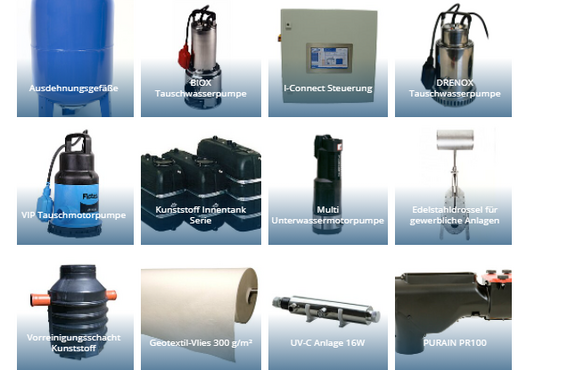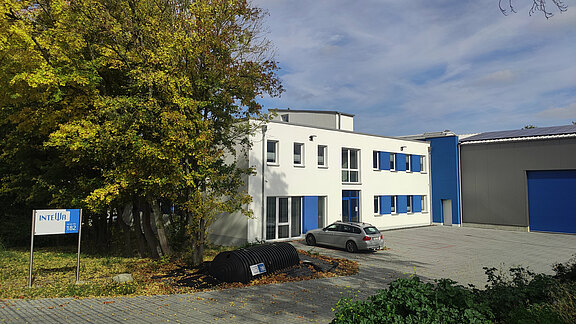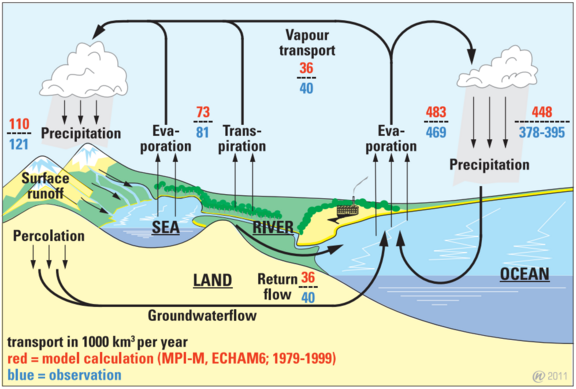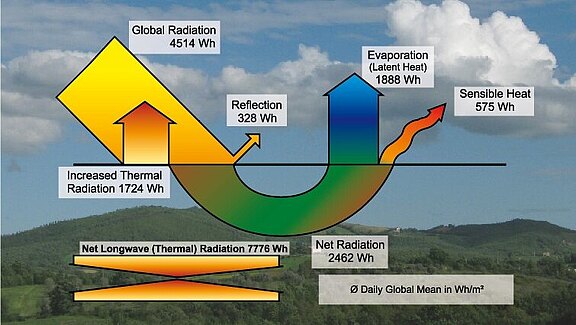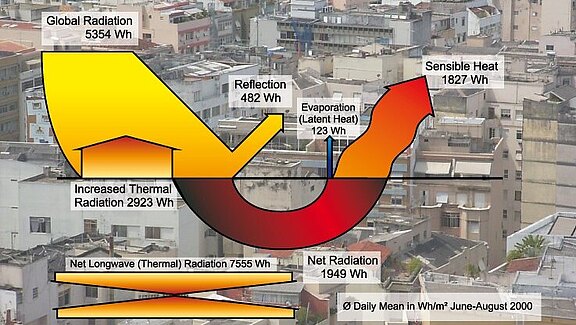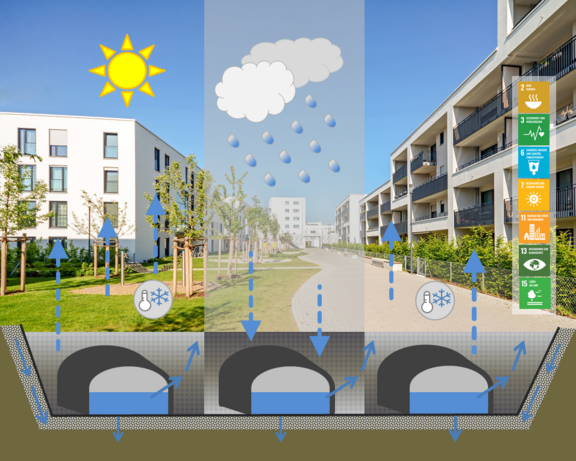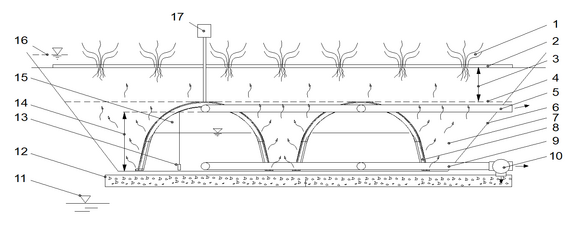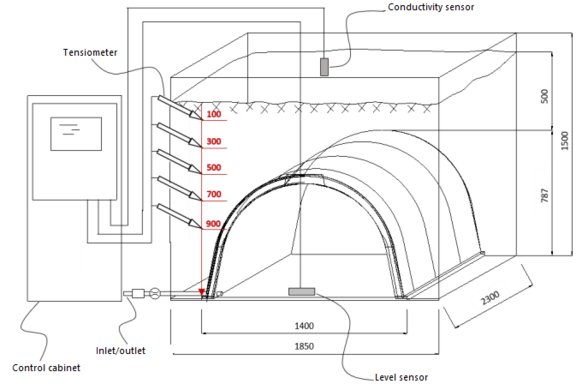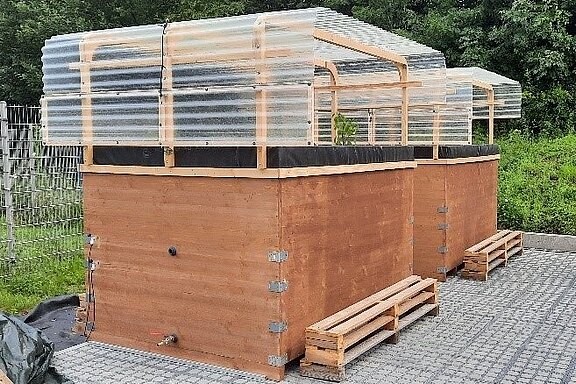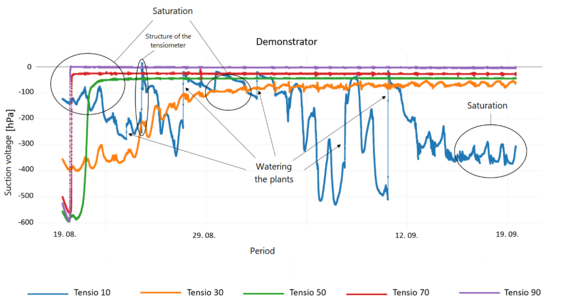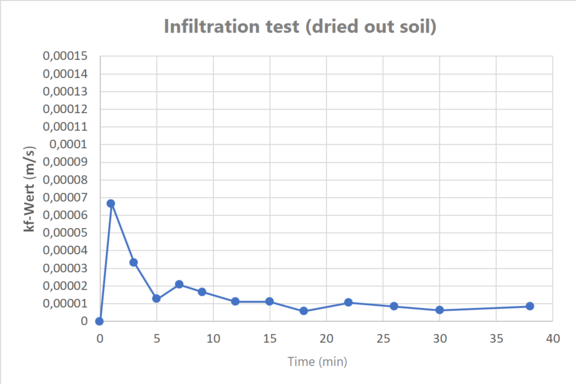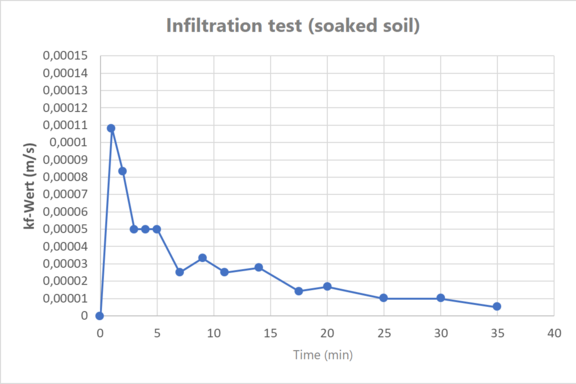New stormwater management solution for municipalities
- with capillary rise store, cool, clean and irrigate -
Within the scope of research and development work, a completely new stormwater management solution has been created, for which a patent application has been filed. This represents a highly interesting solution for urban areas to the increasingly frequent heavy rainfall events on the one hand and heat and drought records on the other. Developed from the BMBF-funded project AgRain with the aim of securing the wet rice harvest in Burkina Faso, this novel technology is intended to contribute to the regulation of the urban microclimate and offer an energy-free irrigation option. The background, current state of research, functionality and advantages of the new solution are explained in this technical article.
This global water cycle is shown in Figure 1. It involves the evaporation of water over the oceans, which then falls on land in the form of precipitation. This precipitation can then seep into groundwater, evaporate into the atmosphere, or flow back into the oceans. Due to increasing urbanization and increasing sealing of 800 km² per year, this natural cycle is interrupted and can thus contribute to the intensification of global climate change. For example, when water evaporates through natural vegetation, 1,888 Wh/m² per day is used to cool the environment. (Figure 2). In contrast, in a sealed urban space, the same environment is heated with 1,827 Wh/m² and day (Figure 3). Instead of evaporating on site, the valuable rainwater, along with numerous pollutants, disappears into the sewers. Local groundwater supplies cannot be replenished, pollutants are not filtered out, and heavy rain events are not buffered, leading to flooding disasters. The small-scale climate changes measurably.
Measures already being implemented to restore water balance
In order to ensure that stormwater is handled as close to nature as possible, several stormwater management measures are already being pursued and increasingly implemented. These include decentralized attenuation, surface and subsurface infiltration, surface discharge and centralized attenuation for delayed discharge. (Bavarian State Office for the Environment 2016). There are also already important changes in the laws of many states. Since 2010, for example, the amended Water Resources Act (WHG) has in principle obliged every German citizen to collect rainwater accumulating on their newly built property separately from domestic wastewater (toilet flushing, washing machine, wash basin) and either infiltrate it or discharge it into a body of water without mixing it with wastewater, either directly or via a sewer system (§55 WHG). In more and more cities, building regulations also require developers to green buildings.
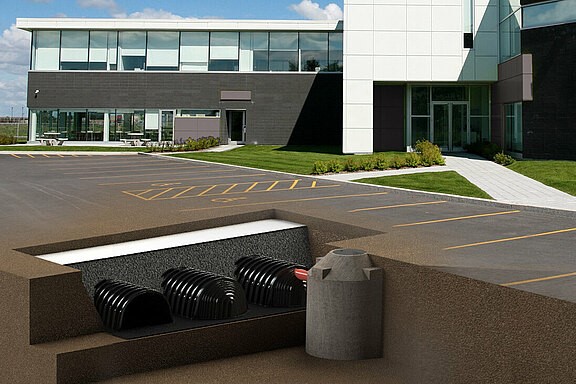
In recent years, a wide variety of stormwater attenuation and infiltration systems have been developed. These include combined attenuation and greening systems, attenuation and infiltration elements, permeable ground coverings, trough trenches and much more.
A completely new and integrative approach is now offered by INTEWA's innovative subsurface irrigation system. Similar to the natural water cycle, this system combines infiltration, attenuation, evaporation and thus cooling, cleaning and irrigation in a new, unique way.
The new stormwater management with the capillary subsurface irrigation system
The novel stormwater attenuation and irrigation system stores seepage water from precipitation underground in a two-dimensional attenuation system. The collected water then rises by itself via the capillary effect without pumping energy. In this way, green areas are either irrigated or the surrounding area is cooled with 670 kWh/m³ using the evaporating water. Due to the resulting high soil moisture, the infiltration capacity of the existing soil is also drastically increased, thus reducing surface runoff in the event of heavy precipitation. This and the constructive design as a trough trench system, catch heavy rain events and fill the reservoirs again and again with rainwater. This creates a valuable cycle that improves the microclimate in cities and can solve drainage problems at the same time. Rainfall is the primary source of water. In addition to local infiltration, the water can also be fed into the storage system from the surrounding sealed, partially sealed or other surrounding surfaces via an inlet, as in a normal attenuation system. If needed, standing surface water and high groundwater can also serve as a water source if the primary purpose is irrigation or cooling. Overflowing water from the storage system can percolate below the system and replenish the groundwater supply.
The main advantages of the new technology at a glance:
- Cooling the environment through evaporation
- Local evaporation creates new precipitation in the surrounding area, thus preventing desolation
- Irrigation of the greenery above the system without energy use through capillary rise
- Preventing flooding through attenuation and dramatically improving the infiltration capacity of the soil
- Replenishment of groundwater reserves
- Purification of polluted precipitation water
Technical system description
Figure 6 shows an example of a variant of the new stormwater attenuation and subsurface irrigation system. The system is divided into an artificial water storage zone and a root zone above it. The water storage zone (14) consists of water storage elements (8) filled with water and a layer of air (15) and the surrounding soil zone (7). The water storage elements are designed as DRAINMAX tunnels made of plastic. In the version shown, these form interconnected rows with pipes (9) and are laid with a spacing of at least 20 cm. The stored water enters the soil zone (7) through holes in the walls of the storage elements. This lies in the water storage zone and serves to transport the water by capillary action from the openings in the water storage elements to the root zone above. The system is separated from the rest of the soil body by laying a waterproof sheet (6). The storage elements have an inlet and outlet (10). This enables filling of the tunnel or controlled seepage into the surrounding soil outside the system. The inlet and outlet can be inspected and flushed via inspection shafts. Another variant is to infiltrate the water in addition to the drainage organ by means of a attenuation basin (16) arranged above. In this case, the foil is cantilevered above ground to form a foil trough. The precipitation water is retained in this area. Below the foil trough, a drainage layer (12) can allow the overflowing water to seep into the ground.
In addition to water replenishment, addition of nutrients is possible. On the surface above the system, the type of planting (1) depends on the construction height of the system as well as the soil type, the ambient conditions and the use of agricultural machinery or the soil load capacity. As an alternative to irrigation of plants, only evaporation through capillary cover layers can be used. In principle, all plants up to a root depth of 1.5m are suitable for the system under consideration. Below the foil trough (6) there is an additional drainage layer (12). This has the task of distributing the overflow water from the attenuation basin (16) outside the system evenly into the soil surface below. In addition to the overflow, water from the drainage device (10) can also be directed out of the system and infiltrated through the drainage layer (12). This can result in recharge of the groundwater (11). In order to be able to regularly check the salt content of the stored water, a conductivity sensor (13) can be mounted in the water storage element.
The capillary rise
As a result of soil drying, there is not only a change in the soil structure, but also a significant influence on soil biology. The number and activity of bacteria decreases and with it the nitrogen fixation in the soil. The soil's ability to breathe is reduced and undesirable fungal growth is promoted. Even weeks after the soil has been rewetted, there is often no discernible regeneration of the soil biology.
In the area of plants, soil desiccation is noticeable by the closure of stomata in the leaves, resulting in a decrease in photosynthesis and thus a reduction in CO2 uptake and the production of oxygen. The restricted growth of the plant increases the negative impact on the inner-city climate.
Capillary rise hight
Therefore, special attention must be paid to the soil in this system. Irrigation of the greenery or even just for evaporation with the help of the capillary effect is a type of micro-irrigation. Ideally, the movement of water is controlled by the suction of the soil, which in turn is created by the suction of the plants. (Nalliah and Ranjan 2010) This suction or capillary tension indicates how much stored water is retained in the soil pore. It corresponds to the force that must be exerted by the roots to extract the water from the pore. Thus, it corresponds to the water attenuation capacity of the soil or the capillary rise height. Specifically, the smaller the soil pore, the greater the capillary rise height and suction tension. (Boley and Adam 2012) Accordingly, the functionality of the capillary rise in the considered system depends, on the one hand, on the soil type due to the grain diameter. On the other hand, the capillary rise is also determined by the degree of soil compaction.
Table 1 below shows the grain and pore diameters and the corresponding capillary rise for different soil types. Accordingly, the highest capillary rises are achieved in fine sand, silt and clay.
| Material | Grain diameter [mm] | Pore diameter [mm] | Capillary rise [cm] |
| Fine gravel | 5 - 2 | 1 | 1,5 - 2,5 |
| Coarse sand | 1 – 0,5 | 0,1 – 0,2 | 5 - 15 |
| Medium sand | 0,5 – 0,2 | 0,06 | 10 - 50 |
| Fine sand | 0,2 – 0,1 | 0,02 – 0,03 | 15 - 150 |
| Silt | 0,1 – 0,002 | 2 – 6x10-3 | 100 - 1000 |
| Clay | <0,002 | <2x10-3 | >1000 |
Table 1: Soil types with associated grain and pore diameters as well as capillary rise (Mull and Holländer 2002; Fetter 2014; Lohman 1972)
Usable field capacity
However, the supply of water to the plants, i.e. the usable field capacity, depends on the presence of central pores. (Schmitt et al. 2007) From the following table 2, it can be concluded that high usable field capacities for supplying the plants can be expected in soils with silt and/or clay contents. These soils are thus suitable in terms of both their capillary rise and the water supply to the roots.
| Soil type | Pore volume [%] | Coarse pores [%] | Medium pores [%] | Fine pores [%] |
| Sands | 46 ± 10 | 30 ± 10 | 7 ± 5 | 5 ± 3 |
| Silt | 47 ± 9 | 15 ± 10 | 15 ± 7 | 15 ± 5 |
| Clays | 50 ± 15 | 8 ± 5 | 10 ± 5 | 35 ± 10 |
Table 2: Part of pore volume and pore size ranges in the total volume of fine soils (Amelung et al. 2018)
Uprising rate of the water
The so-called uprising rate also plays a role in ensuring an adequate water supply for the plants. This provides information on how quickly the water is supplied from below by capillary action. These ascent rates are related to the soil type and the ascent height starting from the aquifer to the effective root zone. The higher the rise, the lower the rise rate. A capillary rise rate between 0.2 and 5 mm/day is necessary for an adequate supply of replenishing water to the plants. (Mull and Holländer 2002). The maximum possible rise height in soils is 2-3 m overall for the range of rise rates mentioned above. (Amelung et al. 2018) Based on the height of the DRAINMAX tunnel, which is approximately 80 cm, and a minimum cover of 50 cm of soil, water would thus need to rise a maximum of 1.30 m to reach the upper soil layers. The uprising rates of pure silt (U) and sandy-loamy silt (Usl) are particularly high, at 2.8 and 2.6 mm/day, respectively. A prerequisite for exclusively capillary irrigation is low soil compaction.
Test system with demonstrator and reference system
In the project, tests were carried out to investigate the capillary rise and infiltration capacity of a specific soil composition. The tests took place on the premises of INTEWA GmbH in Aachen. The experiment to investigate the capillary rise rate was carried out using two lysimeter systems. One system represents the demonstrator system with an installed DRAINMAX tunnel. The other system served as a reference system without installations. Both systems consist of a rectangular wooden casing with internal dimensions of 2.30 m x 1.49 m x 1.85 m (LxHxW) and a wall thickness of 2.7 cm (see Figure 7).
Result capillary test
A capillary test was used to determine after what time the capillary rise will reach the uppermost soil layers. For this purpose, tensiometers were installed at various soil depths of the demonstrator to indirectly measure the water content.
It was found that there was a relatively rapid increase in the water content of the soil in the area of the storage tunnel. Already 3 hours after filling the storage tank, the soil moisture increased significantly. After another 2 to 3 days, the soil area immediately above the reservoir was soaked. After only 7 days, the capillary rise reached a soil depth of 30 cm and continued (Figure 9).
Planting result
In the project, the demonstrator and the reference system were planted with different types of vegetables (onions, beet, lettuce, peppers). Comparison showed that the plants in the demonstrator had grown and formed significantly better than in the reference system without DRAINMAX tunnel with capillary rise. Both the leaves and the fruits were more pronounced and larger in the demonstrator with the storage system. In the reference system, there was sometimes even a stop in growth or absence of fruit formation.
Result of the infiltration test
If a soil is not continuously soaked, it needs more time to recover. This is shorter the lighter the soil. A heavy soil with a high clay content can store water well, but after drying out it needs a very long time to absorb the water again. On average, this is about 5 mm per hour of rain, while a sandy soil can absorb up to 30 mm in this time. Infiltration tests have shown that a soil that has dried out on the surface can absorb water more slowly than a soil that has soaked through. Figure 10 shows this by means of a column test to determine the hydraulic conductivity over a period of 40 minutes after application of a water column.
In the dry soil, the initial conductivity was 7.0E-5 m/s and dropped to 1.0E-5 m/s after only 5 minutes (Fig. 10a).
A second column test clearly showed the influence of soaking the soil on the water conductivity. In contrast to the dry soil, the initial value here was 11.0E-5 m/s and only dropped to a value of 1.0E-5 m/s after 25 minutes, corresponding to 5 times the time compared to the dried soil (Fig. 10 b).
Benefits for cities and municipalities, conclusion and outlook
The benefits and advantages of the novel capillary irrigation system for municipalities are various:
- In the urban environment of multi-family and tall buildings, the acceptance and benefits of green recreational areas are high. No areas are lost due to underground installation. Areas are restructured and made more valuable in their utility. With appropriate planting, biodiversity is increased.
- There is no need for high maintenance costs due to artificial irrigation, thus significantly saving cost and water resources. No more energy is needed for irrigation.
- A first estimation results in relatively low finished system costs of less than 300.00 / m³. From the point of view of economic efficiency and the municipal budget, it is important that the storage system consists of components that have already been successfully used for many years in the field of stormwater management and offer those responsible in urban planning a high level of safety, for example, through DIBt approval. In an emergency, the systems can also be driven over by fire engines.
- The urban heat islands are cooled with approximately 670 kWh/m³ of evaporated water. Depending on the size of the system, this can be several degrees Celsius in summer. This significantly increases the quality of life of the residents
- New precipitation is generated by the evaporation also in the surrounding area, which counteracts the desolation.
- Polluted, run-off rainwater from sealed surfaces is cleaned by the revitalized soil zones.
- The infiltration capacity of the soil is significantly increased, thus optimizing stormwater management and making it less expensive. Sewer overloading and flooding damage are reduced.
- In the event of an overflow, local groundwater supplies are replenished.
The underground storage system can be used to create sustainable local habitats in urban environments. In addition to green spaces, open, self-regulating water areas are also possible. The creation of such small-scale ecosystems increases the quality of life in cities and reduces CO2 and energy consumption through the cooling effect of evaporation. It is still being investigated to what extent the system can be used under traffic areas with capillary-acting and infiltration-capable surfaces in order to expand the system's range of application. It is to be examined in more detail whether the system can also be used sensibly in the agricultural sector or in private gardens. Further investigations will be carried out and evaluated as part of the research project. Test sites in cities and municipalities are now being sought for the system so that, in addition to the small-scale demonstrator, an application in practice can also be investigated.
INTEWA GmbH
Auf der Hüls 182
52068 Aachen
Tel: 0241-96605-0
Author: Oliver Ringelstein, INTEWA GmbH
Further information:
Basic knowledge stormwater management
Notice:
Modifications of the technical article are only permitted with the express permission of the author!


